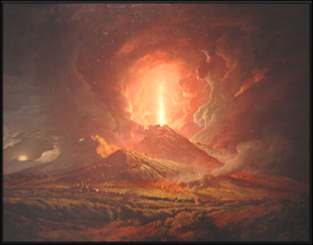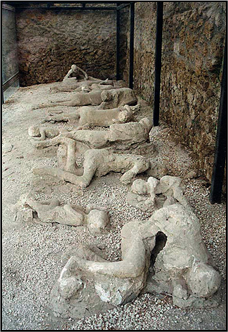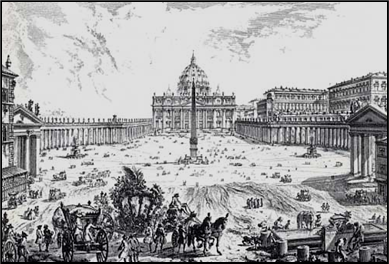


xxxxxIt was in August 79 AD that the huge volcano of Vesuvius, overlooking the city of Naples in southern Italy, erupted violently. Eventually the nearby settlements of Pompeii, Herculaneum and Stabiae were completely covered in a layer of lava, pumice and ash some twenty feet deep. The 2,000 or so inhabitants who did not escape were suffocated, and the area was abandoned. It was not, in fact, until 1592 that evidence of the disaster was uncovered, and not until 1748 (G2) that excavation began in earnest. Many of the buildings were then found preserved under the ash, together with human and animal fossils, and this gave a remarkably realistic picture of life there in the first century AD.
THE CITY OF POMPEII 1592 (L1)
Acknowledgements
Vesuvius: by the English painter Joseph Wright of Derby – Art Collection, Huntington Library of Pasedena, CA. The Dead: photo by Lancevortex. Bulwer-
 xxxxxThe ancient city of Pompeii, situated just thirteen miles south-
xxxxxThe ancient city of Pompeii, situated just thirteen miles south-

xxxxxA description of this disaster is contained in two letters written by the Roman lawyer Pliny the Younger to his friend, the historian Tacitus. In these letters he gives a dramatic, eyewitness account of this tragic event. Within two days the city was covered in a layer of lava and pumice over nine feet deep. This was accompanied by a massive fall of ash, adding another layer of about the same depth. Those who did not manage to escape, or who chose to remain in their homes -
xxxxxThe excavation of Pompeii did not begin until 1748, and it was not until 1763 that an inscription was found to prove that it was, in fact, the ancient Roman city! Excavation has continued intermittently until the present day, and it is now estimated that something like three-
xxxxxIncidentally, the English poet Percy Bysshe Shelley visited Pompeii around 1820. This is a short extract from a poem he wrote afterwards:
I stood within the city disinterred,
And heard the autumnal leaves like light footfalls
Of Spirits passing through the streets, and heard
 The mountain’s slumberous voice at intervals
The mountain’s slumberous voice at intervals
Thrill through those roofless halls. ……
xxxxx…… Later,xin 1834, the English politician and writer Edward Bulwer-
Including:
Domenico
Fontana

L1-
xxxxxThe rediscovery of the site of Pompeii in 1592 was made by the Italian architect Domenico Fontana (1543-
 xxxxxToday, Fontana is best remembered for his work in Rome, where he was architect to Pope Sixtus V for five years. During this time (1585 to 1590), apart from designing the Vatican Library and the Lateran Palace, he collaborated with his fellow countryman, Giacomo della Porta, in completing the dome of Saint Peter's Basilica, broadly based on plans by Michelangelo. He was also responsible for erecting the Egyptian obelisk which now stands in St. Peter's square (illustrated). This obelisk had been brought to Rome in the first century AD and had hitherto stood at the side of the Vatican. And it was Fontana who gave Rome a new city plan, laying out avenues to link up the major churches, planning piazzas as meeting places, and providing obelisks as focal points. His emphasis on link roads and large squares influenced the design of future urban development, and can be seen in Wren's plans for London, drawn up following the Great Fire of 1666 but never used.
xxxxxToday, Fontana is best remembered for his work in Rome, where he was architect to Pope Sixtus V for five years. During this time (1585 to 1590), apart from designing the Vatican Library and the Lateran Palace, he collaborated with his fellow countryman, Giacomo della Porta, in completing the dome of Saint Peter's Basilica, broadly based on plans by Michelangelo. He was also responsible for erecting the Egyptian obelisk which now stands in St. Peter's square (illustrated). This obelisk had been brought to Rome in the first century AD and had hitherto stood at the side of the Vatican. And it was Fontana who gave Rome a new city plan, laying out avenues to link up the major churches, planning piazzas as meeting places, and providing obelisks as focal points. His emphasis on link roads and large squares influenced the design of future urban development, and can be seen in Wren's plans for London, drawn up following the Great Fire of 1666 but never used.
xxxxxThe discovery of the ancient site of Pompeii was made by the Italian architect Domenico Fontana (1543-


